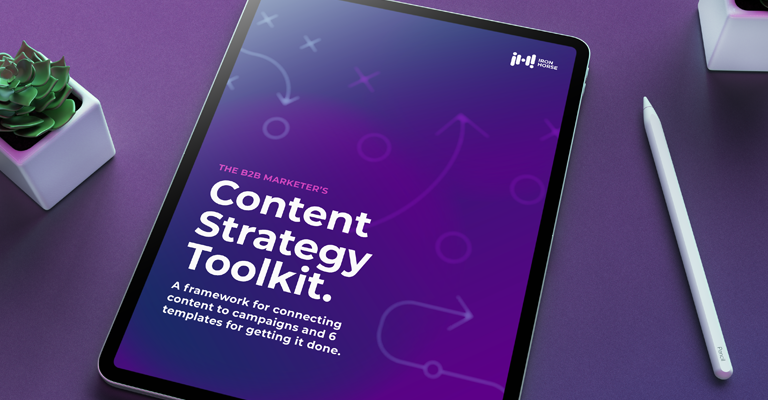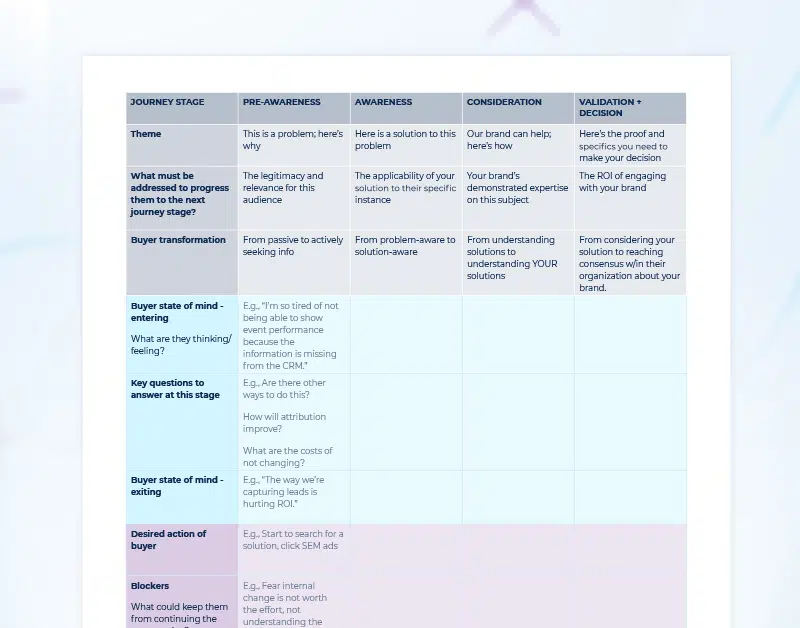Blog

One very common misstep we see marketers take is building content campaigns by assigning assets based on funnel stage. Blogs to TOFU, guides to MOFU, case studies to BOFU.
This isn’t wrong, just incomplete. It IS important to slot assets into journey stages, but you have to ALSO ensure your content is covering the right topics at the right depth for each stage. Another way to think about this is whether the content answers the specific questions your audience has and helps them move forward in their journey.
Content journey mapping is the missing piece of the puzzle. This process helps marketers document, develop and deploy content that more powerfully aligns with their buyer’s journey, prompting desired actions—two of the top challenges highlighted in the Content Marketing Institute’s 2025 B2B Content Marketing Trends report.
We’ve created a template for content journey mapping, and this article will walk you through using it to improve the results of your content campaigns.

Get the free content journey mapping template. Download now
Using the content journey mapping template.
This template consists of two worksheets: the Conversation Arc and the Content Journey Map.
Before you can identify the right content for your campaign, you need to understand how the mindset and needs of your target persona evolve along the buyer’s journey—and how you will shape your messaging to best address them at each stage.
The first worksheet in this template allows you to document this ideal back and forth between your brand and your target audience—the conversation you need to have.

How to complete the Conversation Arc worksheet.
Tip: Create a separate conversation arc for each key target persona in your campaign. For example, if you are targeting “HR leaders” AND “Heads of Finance,” you will want a separate worksheet for each.
Fill in the following information for each journey stage. As you work through the consideration and decision stages, you will likely surface things that impact what you’ve already entered, and you may find yourself making adjustments. That’s okay! The key is to paint as specific a picture as possible of what your target persona is thinking at each stage, and crucially, what questions they have.
Buyer state of mind – entering.
This is your opportunity to really interrogate what the target persona is going through as they enter your funnel. What are they thinking about or feeling, as it relates to this campaign? What kind of challenges or pain points are they experiencing? Try writing in the first person to really get into your persona’s mindset.
Key questions to answer.
This is the heart of the conversation arc. Focus on the questions that will unlock the next funnel stage—what does your audience HAVE to know to move forward in their buying journey? The more specific these questions are, the more useful they will be for content journey mapping.
Tip: Successful content journey mapping relies on knowing the questions your audience needs answered. Creating content that answers those questions ensures your campaign will be customer-centric.
Buyer state of mind – exiting.
This is an opportunity to think about the transformation your target persona needs to undergo to move on to the next funnel stage. If, for example, they entered the stage concerned about losing leads because of outdated CRM software, they might leave the stage much more aware of how losing leads is impacting ROI, and feeling increased urgency to solve that problem.
Tip: Their state of mind as they exit a given stage isn’t necessarily the same as their state of mind as they enter the next stage. Remember, the buyer’s journey is often nonlinear, and people may enter it at any point, not just at the very top.
Desired action of buyer.
Think about what you want the buyer to do at the end of this journey stage. All of your content and messaging should guide the buyer toward this action.
The desired action is NOT:
- The overall goal of the campaign. Instead, think about what you want them to do RIGHT NOW.
- The CTA for a given asset. Where a specific asset might prompt your audience to download another asset or visit a landing page, the desired action here should focus on your audience’s behavior after consuming the content at this journey stage—for example, begin searching for a solution, assemble a buying group, or validate your solution.
Blockers.
What are some issues that could prevent your target persona from continuing along the buyer’s journey? Think about obstacles that could potentially be addressed in your content. For example, if a blocker is, “buying group doesn’t understand impact,” you might consider adding specific content to your program that addresses that issue head-on.
Tip: Even if you do address key blockers late in the funnel, consider moving that content up in the journey—otherwise, your audience may not make it to that late-funnel content.
Messaging.
This is where you’ll pair your company’s existing messaging points with the other info in the conversation arc. Which parts of your story will help answer the questions in this stage?
How to complete the Content Journey Map worksheet.
The second phase of content journey mapping is to plot your content assets against the key questions you surfaced in the conversation arc. This will show you which assets belong at which points in the buyer’s journey, yielding an audience-centric snapshot of the content that will support your campaign.
Like the conversation arc, this worksheet is organized around the stages of the buyer’s journey.

1. Add the questions.
Copy the questions you identified in the conversation arc, by journey stage, into the content journey map. Add one question per cell, creating additional cells as needed.
Tip: You don’t necessarily need to include EVERY question from the conversation arc. You may decide at this step that some questions are redundant, or that multiple questions can be consolidated, or even that some questions are just not that important.
2. Add the content.
Next, add the content and webpages available for the campaign. Make sure to include any solution pages, targeted landing pages, webinars, industry reports, as well as ebooks, blogs, videos and other content assets. Add one asset per line.
Tip: Create a short list of potential campaign assets and evaluate them for fit before adding them to your journey map. In addition to looking at previous performance, note updates that may be needed for this campaign, such as removing dated information, adding links to other campaign content, or adapting general assets for a specific industry.
3. Map the questions against the content.
The moment we’ve all been waiting for! Go down your list and identify which of your audience’s questions each piece of content answers. At the end of this process, you’ll have a clear picture of which questions your content addresses—and which, if any, it doesn’t. Use this information to:
- Narrow down which content to use in the campaign. If you have several pieces that perform the same function, consider how you might test them in different channels or spread them out across the duration of your campaign.
- Plan which content to promote at each stage of the journey.
- Inform internal linking between content assets.
- Identify key content gaps and plan new or revised assets to fill them!

Get 6 free templates for more effective content campaigns. Get toolkit
Subscribe to our blog.
Get unstuck with the most interesting business ideas and our insights delivered to your inbox.